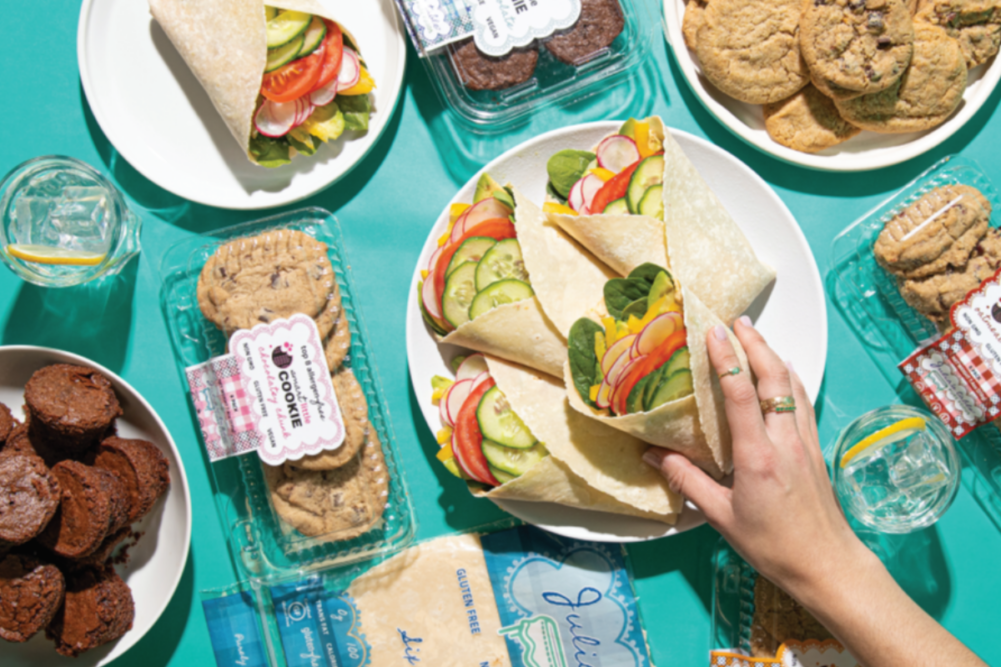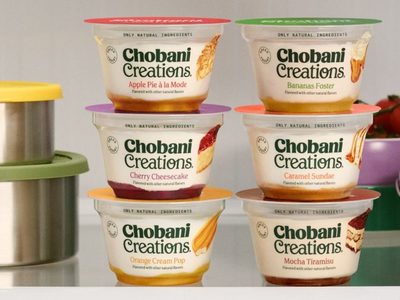KANSAS CITY — For celiac patients, the gluten-free trend has turned into manna from heaven. That’s become even more so since the movement’s pop-culture popularity has fueled a flurry of new products resulting in a cornucopia of better tasting snacks and baked goods for those suffering from the disease and gluten intolerance.
“We have benefitted greatly from interest from celebrities and other people,” said Pam Cureton, clinical and research dietician at the Center for Celiac Research in Baltimore specializing in the treatment of celiac disease. “Is it harmful? It can be low in vitamins, mineral and fiber, but a gluten-free diet can also be undertaken correctly. The biggest harm is going to be to your wallet.”
Nate Fisher, chief executive officer of Salt Lake City-based Julia’s Table, a producer of gluten-free baked foods, remembers what it was like growing up in a family where his mother, Julia, had celiac disease and whose one wish was “to eat just like everyone else.” Years ago, options were sparse. He recalls how his father would bribe him by promising fast food later if he ate the gluten-free meal now.
Today, Julia’s Table offers a variety of certified gluten and allergen-free breads, rolls, cookies brownies and wraps that are co-manufactured and sold across the nation. To reach a broader audience, however, the company creates products made without gluten, and many of them are free of the Top 8 allergens: peanuts, tree nuts, dairy, eggs, fish, shellfish, wheat and soybeans.
Marion Edwards, chief marketing officer, noted the brand’s consumer target audience consists of moms with families seeking healthy choices and lifestyles. Overall, millennials and Gen X families make up about 80% of its social media and subscriber audience.
“Our strategy is inclusivity, not exclusivity, and that is anchored in taste as the first pillar of development,” she noted.
That objective, she added, involves making products not just for those members with major allergies and auto-immune diseases. The line is also positioned as school-safe for students.
Creating allergen-free baked goods that taste more like their conventional counterparts has been a long time coming for Ms. Cureton’s patients, many of whom remember those days when they couldn’t taste the difference between the products and their packaging.
“I’m very excited the way the gluten-free market has boomed the way it has, and I encourage that crossover market,” she said. “I love that my daughter enjoys gluten-free pretzels or some other crackers out there not because they’re gluten-free but because they’re just a good product.”
Ms. Cureton, a member of the Grain Foods Foundation’s Scientific Advisory Board, suggested that the crossover market allows manufacturers to produce gluten-free snacks and baked goods more profitably, but she stressed that the larger group of dieters have so many more nutritious — and less expensive — options besides cutting back on baked goods.
“It’s been a blessing and a curse,” she said. “The blessing is there are so many products that are gluten-free, so the selection is amazing, but it comes at a cost.”

Sharing a medical history
Gluten-free is part of the decades-long, low-carb mentality that has surged and declined as fad diets have come and gone. Several diets have one thing in common: They started as a way to treat and alleviate the symptoms of a condition or disease; then the diets morphed into the mainstream as a so-called health-and-wellness initiative.
Ms. Cureton noted that the ketogenic diet was originally formulated after studies showed that eating high-fat, high-protein, no-carb foods could provide help for epileptics who suffered from seizures. Likewise, the FODMAP movement was initially developed for people with irritable-bowel syndrome.
Tom Vierhile, vice president of strategic insights, North America, Innova Market Insights, pointed out that gluten-free has matured with growth in new product launches moderating across packaged food and beverage products.
Specifically, Innova’s database shows that national launches of gluten-free products grew at a compound annual growth rate (CAGR) of 3.5% from 2016 to 2019. The top category, snacks, saw introduction growth at an 8.0% CAGR during that period, while new baked goods increased at a healthy 5.7% CAGR.
Bakery is also the top category for keto within the gluten-free spectrum, followed by the cereals and sports nutrition categories. Overall, gluten-free contains no wheat, barley or other grains that contain gliadin and glutenin while keto greatly restricts carbs. Some formulations may contain higher carbs than might be expected, which are then balanced by high fiber.
Mr. Vierhile reported that the number of “keto” or “ketogenic” gluten-free bakery and cereal products have been growing rapidly, though from a relatively modest base. According to Innova’s database, new “keto” or “ketogenic” labeled gluten-free products have risen at a 94.7% and 164.0% CAGR for the 2016 to 2019 period respectively.
But look out for another new movement that could disrupt the gluten-free trend: products claiming to be grain free. According to the Innova database, new food and beverage products with a grain-free claim — measured by using terms like “no grain,” “without grain” or “free from grain” — grew at a 14.1% CAGR from 2016 to 2019.
Mr. Vierhile said grain-free is only about 10% as large as gluten-free from a new product launch perspective, but it remains an area to keep an eye on for the future. Formulating these products has never been easy.
51% of consumers who are 18 and older would like more information on nutrition.
Mintel – Consumer Approach to Nutrition, January 2020
During gluten-free infancy, some bakeries relied on starches, additives and sugars as replacements to maintain taste and product integrity, noted Tim Pollak, partner and head of strategy for Bethlehem, Pa.-based Factory LLC, whose brands include Mikey’s baked goods, including grain-free English muffins.
“Consumers who chose gluten-free for the ‘health halo’ unknowingly got products that were often worse for them than those with gluten,” Mr. Pollak said. “Today, more manufacturers are making a conscious effort to bake nutrition into their gluten-free products, not just remove the gluten. They are offering more and better-tasting gluten-free alternatives.”
Mikey’s, he added, has expanded from densely nutritious baked goods to a line of hand-held meals and superfood- enhanced tortillas, while its gluten- and dairy free products incorporate clean, simple ingredients.
“As consumers demand more ingredient transparency, developers have become more creative, experimental and resourceful,” Mr. Pollak explained. “Mikey’s, for example, launched its brand with an English muffin made with almond flour and five other kitchen pantry ingredients. It met the exacting standards of not just gluten-free consumers, but dairy-, grain- and soy-free, keto, paleo, vegan, and Kosher.”
Making a clean break
Ms. Edwards pointed out that clean ingredients have come a long way over the past decade since bakers needed to secure truckloads of alternative flour in advance because there were few options to meet a certified gluten-free standard. Julia’s Table product development team worked with an international consultant to develop a unique milling process for its proprietary alternative flour, which is imported, to create its products.
“It made it super difficult during COVID for us to bake a consistent, quality product,” she said. “That has caused us to reformulate and relaunch products, but at the same time, it has strengthened our supply chain. The lack of gluten coupled with the complexities a free-from allergens approach necessitates is a technological challenge, which must not be underestimated. It requires a broad understanding and a comprehensive approach in food technology to make gluten-free products the best in quality and fulfill our tastes-like-home promise.” While it’s not a gluten-free option, Natural Ovens’
Keto-Friendly bread by Alpha Baking Co. has 12 grams of carbohydrates and 12 grams of dietary fiber, which together slashes the net carbs per slice.

Tim Lotesto, senior director, national retail key accounts, said the Chicago-based company worked in close partnership with an ingredient supplier on the formulation to get to the carb and fiber counts it wanted “without turning the ingredient legend into a novel.” He added that formulating required a balancing act between producing a dough that will run on commercial equipment and creating a tasty bread that meets keto-friendly standards. It shows how some mainstream wholesale bakers are playing to the keto phenomenon.
“I think keto is popular because it works,” he said. “It may not work for everyone, but those who benefit often see dramatic results.”
Indulging in gluten-free
As a dietician, Ms. Cureton wouldn’t recommend a gluten-free diet for people who want to lose weight because many products contain high levels of refined rice or another alternative flour and starches as well as a low amount of fiber.
“Weight gain is very common for our celiac patients,” she said.
Handmade caramel, chocolate, raspberry jam and fancy pecans add layers of flavor that go a long way when creating dessert bars. Jill Bommarito, founder and president of Ethel’s Baking Co., Shelby Township, Mich., noted that its treats must pass the taste test for gluten-free and “gluten-full” consumers.
“We will not bring an item to market that is ‘good for gluten-free,’” Ms. Bommarito said. “It must be fantastic and outperform traditional products in the same space.”
Ethel’s small-batch specialty bars include such varieties as its signature Pecan Dandy that comes with a shortbread butter crust and caramel that’s topped with large pecans.
“ I love that my daughter enjoys gluten-free pretzels or some other crackers out there not because they're gluten-free but because they're just a good product." — Pam Cureton, Center for Celiac Research
Ms. Bommarito noted the company is “in this for the long haul” with indulgent products that remain relevant despite variations to diets and shifting consumer trends.
“We are here to be that special treat that grandma would have made for you,” she said. “We have benefitted from other specialty diets in that all are educating consumers, helping them become better label-readers and helping them understand the calories they are investing in. We believe Ethel’s taste, clean ingredients, transparency and commitment to craft add value for consumers that care about the food choices they make for themselves and their families.”
A three-pack of the dessert bars, or about 9 oz. of product, has a suggested retail $8.99 to $9.99 while a new single-serve bar goes for $2.99.
“The cost of our products is not a result of being gluten- free as much as due to the quality of nuts, butter and chocolate, along with time being our largest ingredient,” Ms. Bommarito said. “We won’t compromise on taste.”
Mr. Pollak uses terms such as “transparent” and “trust” to describe Mikey’s products for people who follow a gluten-free or allergen-friendly diet. The strategy is to branch beyond gluten-free with baked goods that offer clean labels, dense nutrition, variety and, of course, great taste.

“To the extent some people feel self-conscious or stigmatized eating restrictive diets, the growing popularity of specialty diets is validating,” he said. “It makes gluten-free feel less ‘medicinal.’ The overlap of benefits — for example, Mikey’s English muffins are keto and paleo in addition to being gluten-, grain-, dairy- and soy-free — presents an opportunity to introduce allergen-friendly eating to low-carb seekers.”
Mr. Pollak suggested that consumers who perceive gluten-free as synonymous with better-for-you may be disillusioned when they discover that removing gluten does not add nutritional value.
“An educated consumer needs to be knowledgeable about both diets and brands,” he said. “As Mikey’s has prioritized nutritional value and taste, educated consumers have become our most loyal customers.”
Ms. Cureton strongly suggested that consumers consult with a dietician or health professional to determine whether a gluten-free, keto or any other diet is appropriate, if not only for their health and well-being but also for their pocketbooks.
“There’s no harm with eating gluten-free bread, except for the price,” she said. “The manufacturers are helping a specific population that desperately needs their products, and I’m very thankful that they’re able to make these products for people who need them.”
And yes, for those suffering from celiac disease, that’s more manna from heaven that they can enjoy.




